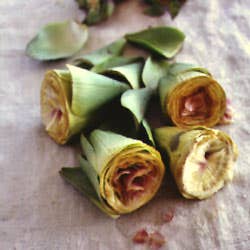
Preparing Artichokes
Preparing artichokes can be tricky, but we've got a few helpful tips to make the job easier:
PARING: Americans usually discard the tasty stems of the artichoke. Syrians, however, waste little, and know that the artichoke's stem can be as delicate as its heart. Using a paring knife or vegetable peeler, trim away the stem's fibrous outer layer, rub with fresh lemon to prevent discoloration, and leave intact when cooking whole artichokes—then slice and use in place of, or in addition to, hearts in many recipes (or simply saute in olive oil with garlic, salt, and pepper).
TRIMMING: The tips of the artichoke's bracts, more commonly called leaves, are barbed (this is a thistle, after all). On some varieties, the tips are needlelike and can do serious damage to your hands. To avoid getting pricked, trim all full-size artichokes before handling them further. Using a very sharp or serrated knife, slice off the top 1/2" to 1" of the closed leaves. (Those of baby artichokes have not yet developed thorns, and therefore don't need to be trimmed.)
MORE TRIMMING: Some people simply throw whole artichokes into a pot of boiling water, but the finished product ends up looking better and is easier to work with if the leaves are trimmed further before cooking. First, pull away one or two layers of the tough outer leaves around the base, then use sharp scissors to cut off the ends of each outer leaf. Rub trimmed surfaces with fresh lemon to prevent discoloration; then the vegetable is ready to cook.
REMOVING THE CHOKE: Removing the hairy, inedible choke from a raw artichoke can be a chore; it's much easier to do after the artichoke has been cooked, when the choke can be easily spooned out. Unfortunately, some stuffed-artichoke recipes call for removing the choke before cooking. To do this, gently spread apart the pretrimmed leaves, pull out and discard the pale, thorny, innermost leaves, then scrape out the choke with a spoon or melon-baller and discard it.
Keep Reading
Continue to Next Story










